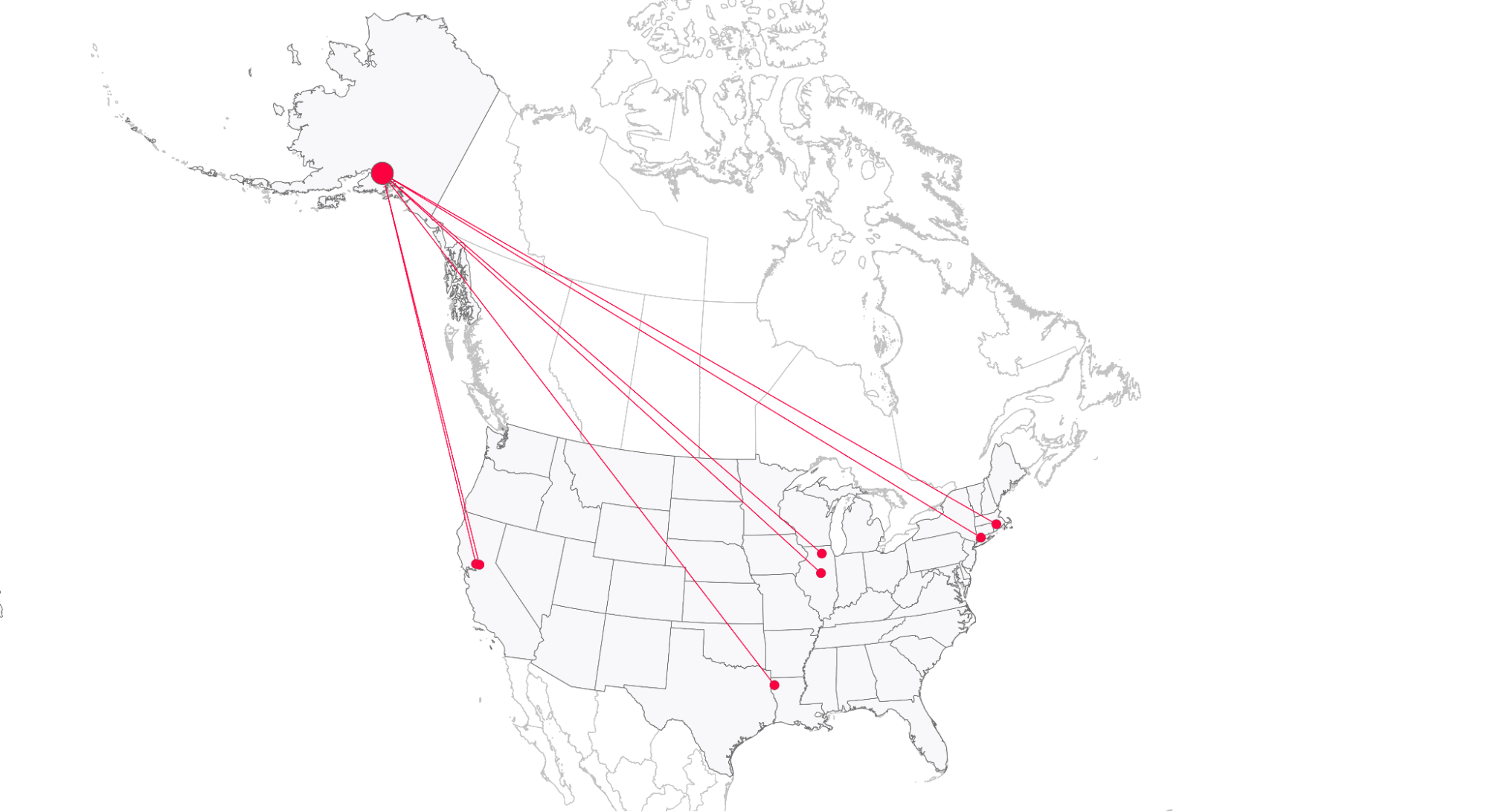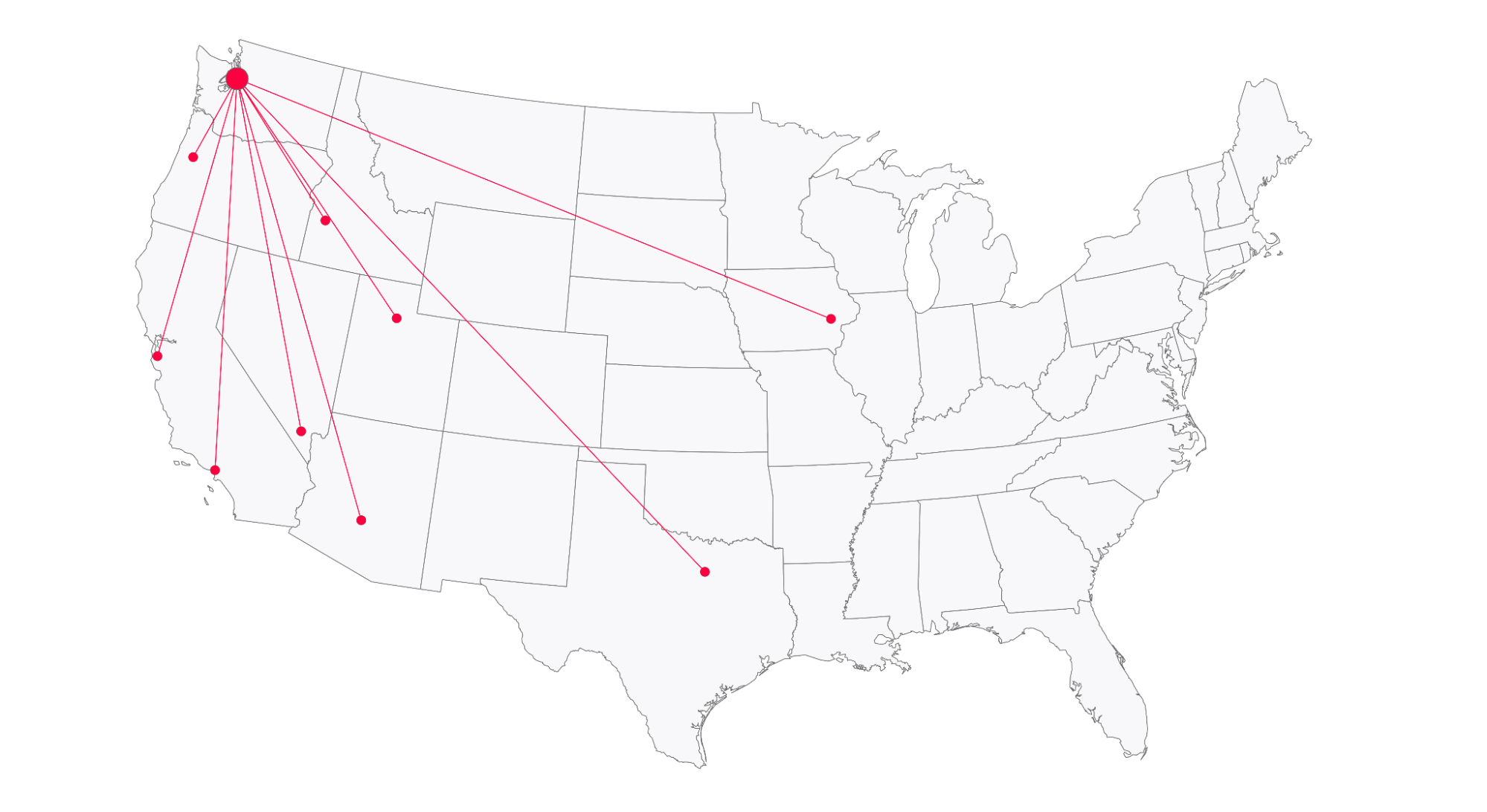With a packed schedule from January through April, NCAA gymnasts spend much of their time on the road during the season. We analyzed select schedules for the 2024 season and found that the average distance a team travels to an away meet is 472 miles. This number includes teams that travel about 100 miles to meets as well as those that travel over 1,000 miles. We wanted to know: Which teams cover the most miles over the course of the season? Which teams tend to compete closest to home? Do teams within the same conference travel similar distances?
To find out, we analyzed schedules released before December 1st, and calculated distances between home and away campuses. For neutral site meets, we calculated distances between each participating team’s campus and the arena. Regionals and nationals are not included. Distances were calculated using the Haversine formula, which takes into account the earth’s curvature when measuring the distance in miles between two points.
Which teams are traveling the farthest?
1. Alaska

Alaska is the clear geographic outlier in NCAA gymnastics. Due to the long journeys, the Seawolves compete in more than one meet each weekend to make the most of the trip. Even with that accommodation, the team has the potential to travel over 26,000 miles throughout the season. For comparison, traveling once around the Equator is 24,900 miles.
As a point of reference, here are a few of their travel weekends in 2024. In late January, the Seawolves will compete in Connecticut against Bridgeport, 3,362 miles away. From there, they have a quick 100 mile trip to Brown, followed by 3,384 miles back to Alaska. An early February trip for two meets at Centenary adds 6,327 more miles. In late February, Alaska heads to Illinois for meets at Illinois State and Northern Illinois, adding almost 5,580 miles. March brings a nearly 2,000-mile trip to UC Davis and Sacramento State, only 18 miles apart. In addition, MSPF Championships will be held at Sacramento State. If Alaska travels home in between, the team’s season mileage will be 26,884, compared to just under 23,000 miles if not.
2. Washington

Combining round-trip travel for nine away meets in 2024, Washington will cover 16,420 miles – enough to drive the length of Route 66 almost seven times. Travel to Iowa and the Metroplex Challenge in Forth Worth, Texas will each be over 3,000 miles round trip. The Huskies have a third meet over 1,000 miles away at Arizona State. Their closest meet is at Oregon State in March, just 219 miles away.
3. Iowa State

Iowa State logs the second most mileage of any team in the contiguous United States. With 10 away meets on the 2024 schedule, the Cyclones will travel to three meets that are over 1,000 miles away: Boise State, Southern Utah, and Florida. Even with a February two-meet weekend in Utah saving a round trip, Iowa State will travel almost 15,000 miles this season – more than three trips up and down the Mississippi River.
Differences Within Conferences
Conference alignments impact how far teams travel each season. Some conferences are spread out geographically, while others are very close together. To quantify the range of schedules within each conference, we created a multiplier: the most traveling team’s distance divided by the least traveling team’s distance.
| Conference | Average 2024 Distance Travelled | Most Travelling Team | Miles | Least Travelling Team | Miles | Multiplier |
| MPSF | 12,696 | Alaska | 26,884 | Sacramento State | 5,733 | 4.7 |
| Big 12 | 10,865 | Iowa State | 14,984 | Oklahoma | 7,448 | 2.0 |
| Pac-12 | 10,224 | Washington | 16,420 | Utah | 4,984 | 3.3 |
| Big 10 | 8,759 | Minnesota | 10,849 | Maryland | 5,991 | 1.8 |
| MIC | 7,840 | Illinois State | 10,577 | Lindenwood | 3,823 | 2.8 |
| Mountain West | 7,703 | Air Force | 10,663 | Boise State | 4,151 | 2.6 |
| ACC | 6,971 | North Carolina | 8,454 | Pittsburgh | 4,320 | 2.0 |
| SEC | 6,876 | Kentucky | 9,600 | Georgia | 4,934 | 1.9 |
| GEC | 5,854 | Southern Connecticut | 10,316 | Cornell | 3,126 | 3.3 |
| EAGL | 5,480 | New Hampshire | 7,099 | Temple | 4,354 | 1.6 |
| MAC | 4,347 | Central Michigan | 6,689 | Western Michigan | 2,737 | 2.4 |
| Independent | 4,067 | Fisk | 5,633 | Greenville | 2,532 | 2.2 |
| WIAC | 2,207 | Gustavus Adolphus | 4,268 | UW-Eau Claire | 1,080 | 4.0 |
| NCGA-East | 1,686 | Rhode Island College | 2,297 | Ithaca | 986 | 2.3 |
The MPSF, which includes Alaska, will cover the most miles this season. The other three MPSF teams – UC Davis, Southern Utah, and Sacramento State – will cover an average of almost 8,000 miles in 2024. Sacramento State will travel the fewest miles in 2024 at 5,733. Alaska will cover 4.7 times this distance.
Among the Power Five (Big 12, Pac-12, Big 10, and SEC), the Big 12 teams, led by Iowa State’s sojourns, will average 10,865 miles over the course of the season. Oklahoma will cover the least ground in the conference, traveling 7,448 miles, due in large part to three meets within 200 miles of campus. Comparatively, Iowa State’s closest meet is more than 500 miles from campus, meaning that the Cyclones will cover two times Oklahoma’s mileage.
Pac-12 teams will cover an average of 10,224 miles. Washington will travel the farthest, 3.3 times farther than Utah. Utah will compete three times at the Maverick Center, which is just seven miles away from campus. In total, they’ll travel 5,000 miles this season. Stanford, Arizona, and Oregon State will each travel over 11,000 miles.
The average Big 10 team will travel 8,759 miles. All but two teams have at least one meet located more than 1,000 miles from campus, with Penn State’s trip to Southern Utah being the longest at 1,884 miles each way. Minnesota plans to travel the most, at 10,849 miles, 1.8 times farther than Maryland.
The SEC travels the least in the Power Five, with each team averaging 6,876 miles in 2024. Kentucky, at 9,600 miles, will travel 1.9 times as many miles as Georgia, at 3,530 miles. Missouri, Arkansas, and Georgia’s farthest meets are in-conference: Arkansas at Florida (816 miles), Missouri at the SEC Championships in New Orleans (634 miles), and Georgia at Arkansas (629 miles).
Outside of the MPSF, the WIAC has the least parity among teams: Gustavus Adolphus, traveling 4,269 miles, will cover four times as many miles as Eau Claire, at only 1,080. The EAGL has the most parity: New Hampshire, traveling 7,099 miles, will cover 1.6 times Temple’s 4,354 miles.
Single Meet Facts
- Outside of Alaska’s competitions, the farthest meets are coast to coast: Yale to San Jose State (2,597 miles), Brown to Oregon State (2,576), Oregon State to Rutgers (2,465), and Southern Connecticut to Arizona (2,176).
- The closest dual meet involves less than three miles of travel, from Temple to Penn.
- Iowa State’s closest meet to home is farther away than any other team’s – they’ll travel over 500 miles to the Big 12 Championship at Oklahoma. Minnesota and Arizona also have far “close” meets – Minnesota’s closest meet is 463 miles away at the Big 10 Championship at Michigan State, and Arizona’s is 452 miles away at UCLA.
READ THIS NEXT: How Are NCAA Gymnastics Schedules Determined?
Article by Jill Walsh




One comment